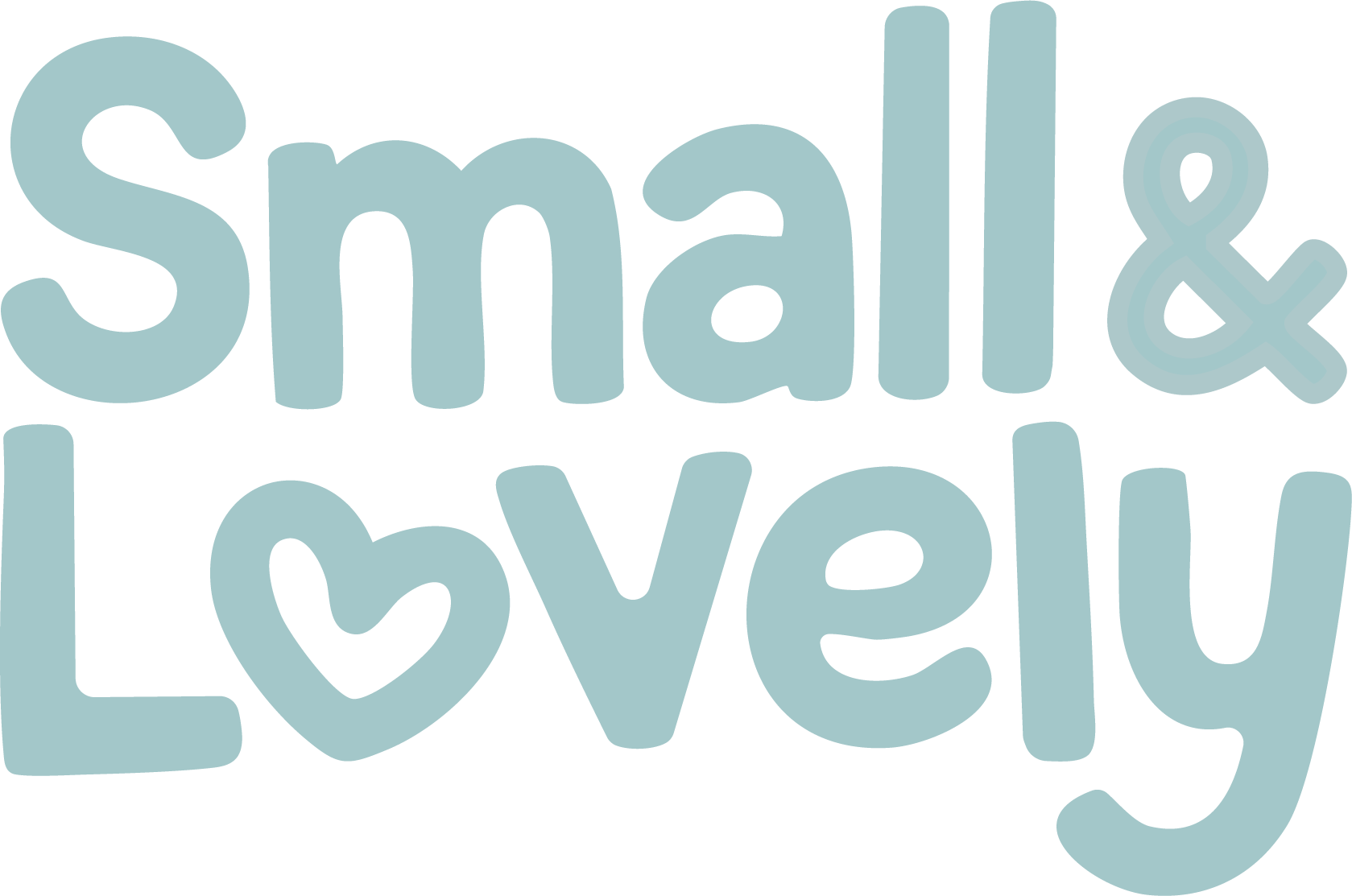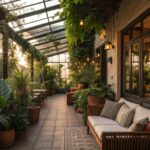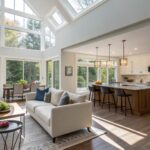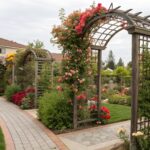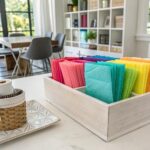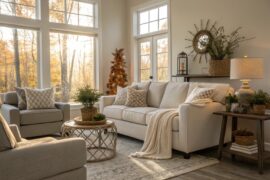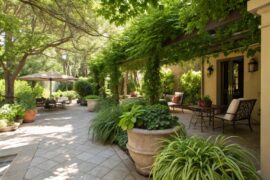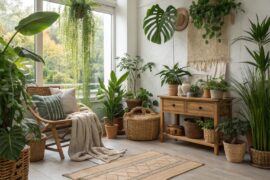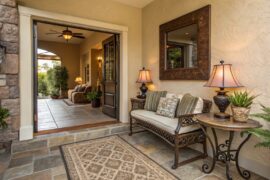When I first encountered a client’s north-facing patio that had been neglected for years, I immediately saw the opportunity others had missed. “It’s too dark to grow anything beautiful here,” she lamented. Three months later, her lush container garden became the highlight of her home’s exterior, proving that shade doesn’t have to limit your gardening ambitions.
Understanding Shade Conditions

Before selecting plants and containers, we need to define what “shade” actually means in gardening terms:
- Full shade: Areas receiving less than 4 hours of direct sunlight daily
- Partial shade: Spaces that get 4-6 hours of sun, often in morning or late afternoon
- Dappled shade: Areas under trees where sunlight filters through leaves, creating a shifting pattern
Take time to observe your space throughout the day, noting how sunlight moves across it. This simple observation will dramatically improve your container garden’s success.
Table 1: Types of Shade and Characteristics
| Shade Type | Sunlight Hours | Common Locations | Container Considerations |
|---|---|---|---|
| Full Shade | Less than 4 hours | North-facing areas, under dense tree canopies | Focus on foliage over flowers, ensure good drainage |
| Partial Shade | 4-6 hours | East or west-facing locations | Can support some flowering plants |
| Dappled Shade | Filtered light throughout day | Under deciduous trees, pergolas | Good for plants that prefer protection from intense sun |
| Bright Shade | No direct sun but abundant reflected light | Near white walls, glass buildings | Can support plants that need more light without direct sun exposure |
The Benefits of Container Gardening for Shade
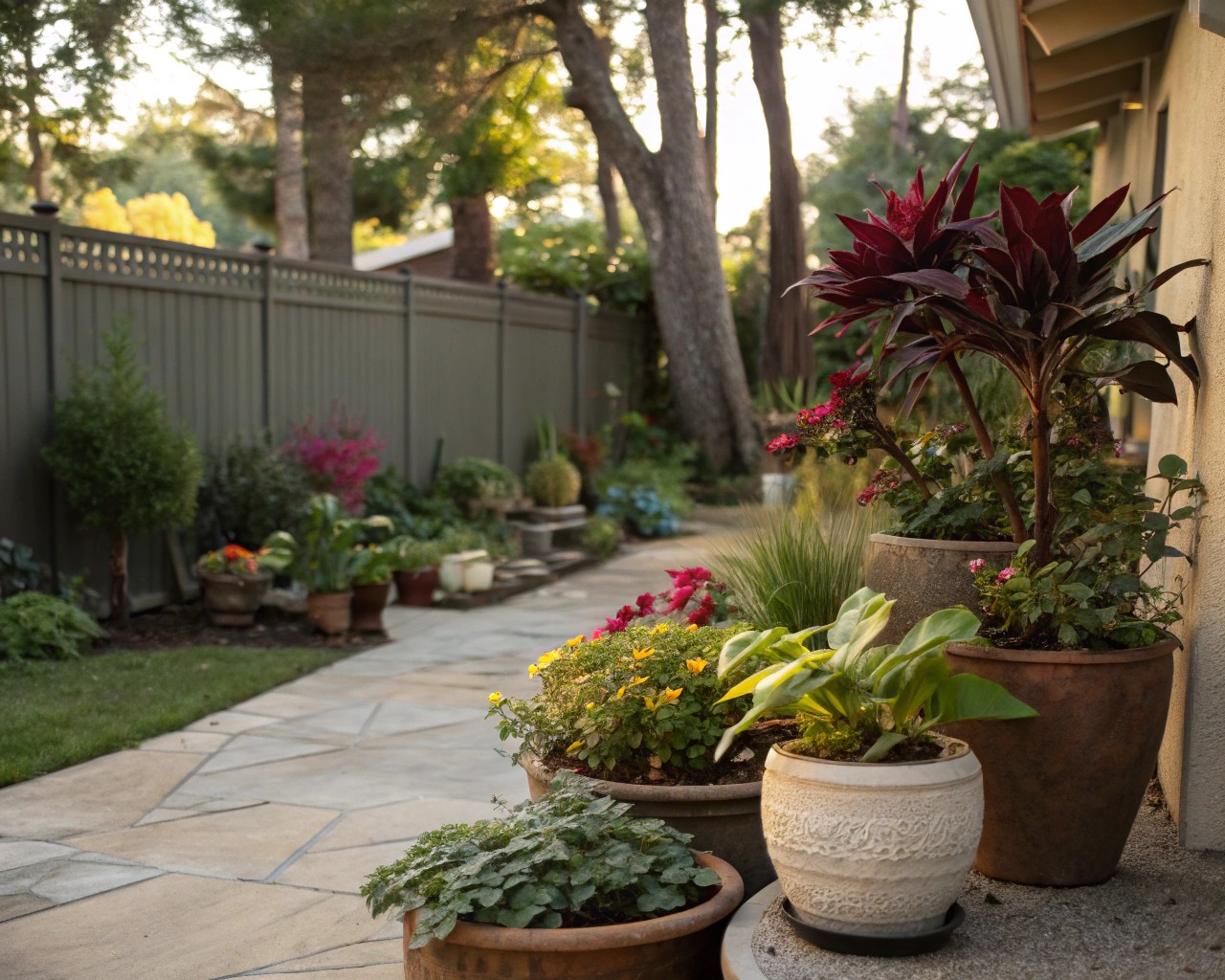
Container gardens offer unique advantages for shady areas that I’ve leveraged in countless design projects:
- Mobility: Move pots to catch seasonal light changes
- Soil control: Create ideal growing medium regardless of existing ground conditions
- Height variation: Elevate plants to maximize light exposure
- Visual impact: Create focal points in otherwise challenging spaces
You’ll discover that containers also allow for experimentation. Container gardening can be seen as a low-commitment way to try new plant combinations without making permanent alterations to your landscape.
Container Selection for Shade Gardens
Materials Matter
Different materials perform uniquely in shade conditions:
- Terracotta: Porous and breathable, helps prevent overwatering in shade
- Glazed ceramic: Retains moisture longer, excellent for shade plants that prefer consistent moisture
- Plastic/resin: Lightweight, affordable, doesn’t dry out quickly
- Metal: Contemporary look, retains heat (beneficial in cool shade)
- Wood: Natural appearance that complements shade gardens
Size and Drainage Requirements
Shade containers often require special attention to drainage:
- Choose containers with sufficient drainage holes
- Consider elevating pots slightly for better airflow
- For large containers, place a layer of gravel at the bottom before adding soil
- Line containers with landscape fabric to prevent soil from washing out while allowing drainage
One approach I’ve used successfully with clients is filling large containers partway with empty plastic bottles before adding soil. This technique helps with drainage and makes large pots less heavy.
Plant Selection for Different Shade Exposures
Full Shade Superstars
These plants thrive in areas receiving less than 4 hours of direct sunlight:
- Hostas: Variety of sizes and colors, from blue-gray to yellow-green variegated
- Ferns: Boston fern, Japanese painted fern, maidenhair fern
- Heuchera (Coral Bells): Stunning foliage colors from purple to caramel
- Begonias: Rex begonias for foliage, tuberous for flowers
- Carex: Grass-like appearance with variegated options
Hostas are widely favoured for shade containers due to their hardiness and the extensive variety of colours and leaf sizes available, making them highly versatile. While they can tolerate some sun, they truly excel in partial to full shade conditions when provided with moist, well-draining soil.
Partial Shade Performers
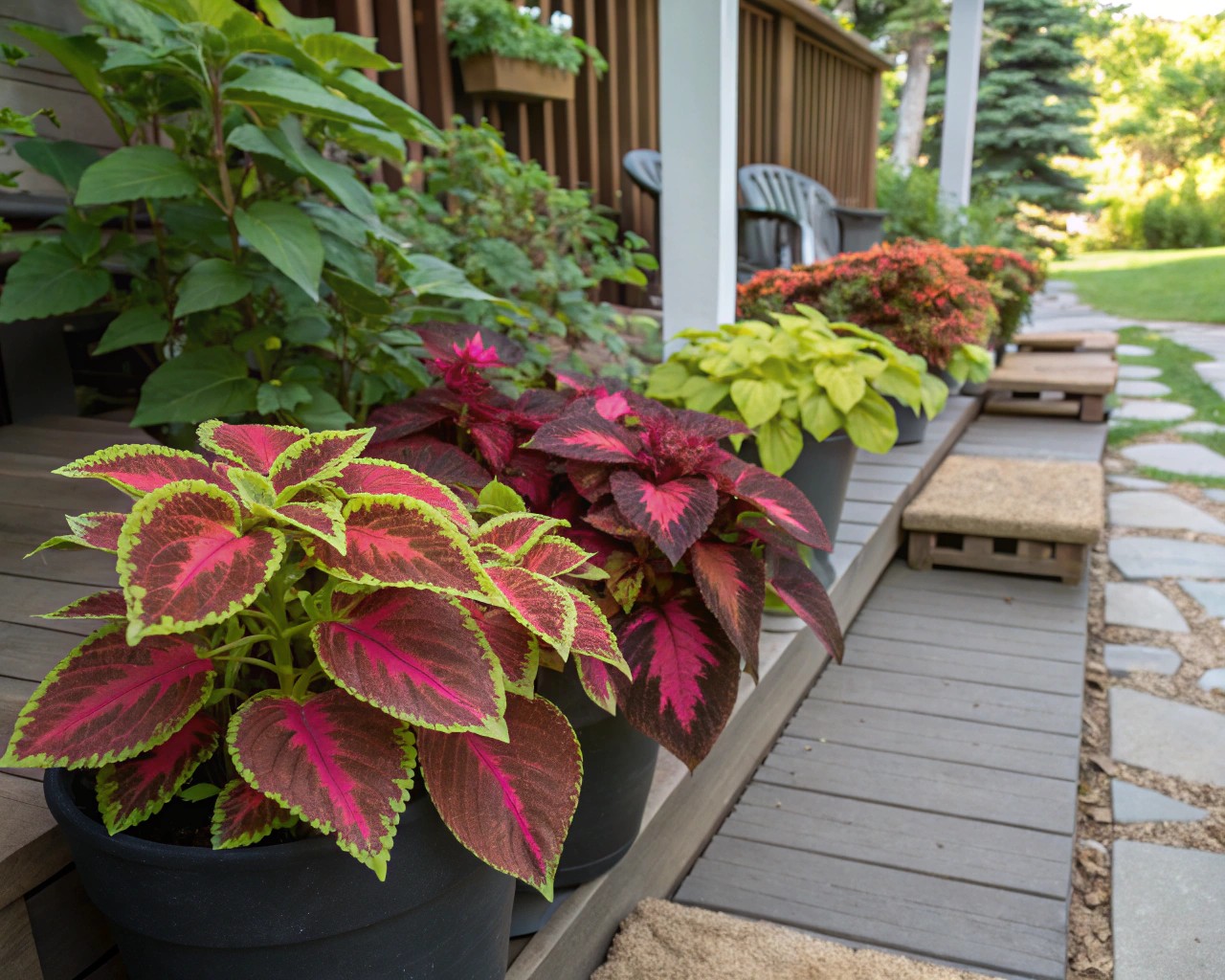
For spaces with 4-6 hours of sunlight:
- Hydrangeas: Compact varieties like ‘Little Lime’ or ‘Bobo’
- Coleus: Endless foliage colors and patterns
- Impatiens: Reliable bloomers for shade
- Astilbe: Feathery flowers in pink, white, or red
- Caladium: Dramatic heart-shaped leaves in white, pink, and red
Dappled Shade Delights
Plants that appreciate the filtered light under trees:
- Brunnera: Silver heart-shaped leaves with blue flowers
- Japanese Forest Grass (Hakonechloa): Graceful arching habit
- Lily of the Valley: Fragrant spring flowers
- Tiarella (Foamflower): Delicate flowers above attractive foliage
- Violas: Sweet flowers that tolerate cooler temperatures
Table 2: Recommended Plants by Shade Exposure
| Plant Type | Full Shade | Partial Shade | Dappled Shade |
|---|---|---|---|
| Foliage Plants | Hostas, Heuchera, Ferns, Carex | Coleus, Caladium, Japanese Forest Grass | Brunnera, Tiarella, Lamium |
| Flowering Plants | Begonias, Torenia, Fuchsia | Impatiens, Astilbe, Lobelia | Hydrangea, Violas, Lily of the Valley |
| Trailing Plants | Creeping Jenny, English Ivy | Sweet Potato Vine, Bacopa | Vinca Minor, Creeping Thyme |
| Vertical Accent | Japanese Painted Fern, Sago Palm | Compact Hydrangea, Fuchsia | Dwarf Bleeding Heart, Foxglove |
| Winter Interest | Evergreen Ferns, Hellebores | Dwarf Conifers, Skimmia | Snowdrops, Winter Aconite |
Design Principles for Shade Containers
The “Thriller, Filler, Spiller” Approach

This classic container design formula works beautifully in shade:
- Thriller: Tall, upright focal plant (Japanese painted fern, tall heuchera, upright fuchsia)
- Filler: Mid-height plants that add volume (coleus, begonias, impatiens)
- Spiller: Trailing plants that cascade over edges (creeping Jenny, sweet potato vine, ivy)
Container gardening offers remarkable flexibility, allowing you to reposition plants and experiment with diverse plant types and colours without commitment to in-ground planting. This approach proves that even areas with limited sun can support thriving plant life, particularly when using pots or containers.
Color Considerations in Shade
Shade gardens offer unique color opportunities:
- Silver and white foliage: Brightens dark corners and glows in low light
- Chartreuse and gold: Creates the illusion of dappled sunlight
- Blue and purple: Recedes visually, creating depth
- Red and orange: Use sparingly as dramatic accents
One of my favorite client transformations involved a deeply shaded urban courtyard where we used predominantly white-variegated plants. The effect was magical at dusk, when the white seemed to glow in the darkness.
Texture and Form Importance
In shade gardens, where flowering may be limited, texture and form become crucial:
- Contrast fine textures (ferns, grasses) with bold leaves (hostas, begonias)
- Mix upright forms with mounding and trailing habits
- Consider leaf shapes: round, heart-shaped, palmate, narrow
- Include plants with different surface qualities: glossy, matte, fuzzy
Shade containers provide a fantastic opportunity to experiment with the rich tapestry of foliage colours and textures, enabling the creation of lush, perhaps even tropical-inspired, beautiful arrangements that one might not typically attempt in a traditional garden bed.
Case Studies: Transforming Shade with Containers
The North-Facing Apartment Balcony

Client challenge: A 12’x4′ concrete balcony receiving less than 3 hours of morning sun, with limited weight capacity.
Solution: We created a layered design using lightweight fiberglass containers that mimicked concrete. The plant palette included:
- Dwarf Japanese forest grass as a “thriller”
- Silver-leaved heuchera and deep purple ajuga as “fillers”
- Variegated creeping Jenny and black mondo grass as “spillers”
Result: The textural interplay and color contrast created year-round interest, while the lightweight containers ensured building safety.
The Restaurant Entry Renovation
Client challenge: A high-end restaurant with a constantly shaded entrance that felt unwelcoming.
Solution: We designed large copper containers flanking the entrance, filled with architectural plants that could handle the dark conditions:
- Sago palms as dramatic focal points (hardy in zones 9-11)
- Variegated hostas and hybrid begonias for mid-height
- Boston ferns cascading over the edges
Result: The entrance became a signature feature that enhanced the restaurant’s upscale image while performing beautifully in deep shade.
The Accessible Garden for Mobility Challenges
Client challenge: An elderly client who loved gardening but could no longer manage in-ground plantings.
Solution: We created a container garden on her shaded patio using elevated planters at various heights:
- Raised cedar boxes at seating height
- Colorful glazed pots on wheeled platforms for mobility
- Waist-height troughs with irrigation systems
Result: The client could continue gardening from her mobility scooter or while seated, with plants selected for easy maintenance in shade.
This approach resonates with many gardeners facing physical limitations, as one shared: “To accommodate my physical irritations, I have made concessions on what I do in the garden… I have turned to doing more gardening in containers.”
Seasonal Considerations
One of the challenges in shade container gardening is maintaining year-round interest. I approach this by planning seasonal transitions.
Spring Awakening
Early spring offers unique opportunities in shade gardens:
- Spring bulbs (snowdrops, species tulips, woodland hyacinths)
- Hellebores for winter-to-spring transition
- Early unfurling ferns
- Seasonal pansies and violas
Summer Fullness
For summer impact:
- Coleus and caladium for tropical drama
- Begonias and impatiens for consistent flowers
- Ornamental grasses for movement
- Ferns at peak display
Fall and Winter Interest
Extend your container garden season:
- Dwarf evergreens for winter structure
- Ornamental cabbage and kale
- Winterberry and red-twig dogwood for stems
- Evergreen ferns and heuchera
Table 3: Seasonal Maintenance Calendar for Shade Containers
| Season | Planting Activities | Maintenance Focus | Display Highlights |
|---|---|---|---|
| Early Spring | Plant spring bulbs that were pre-chilled, add cool-season annuals | Clean containers, apply slow-release fertilizer | Early bulbs, hellebores, emerging fern fronds |
| Late Spring | Transition to summer plants after last frost, divide crowded perennials | Increase watering as temps rise | Spring flowering shade perennials, maturing foliage |
| Summer | Replace any struggling plants, add tropical accents | Regular watering, occasional liquid fertilizer | Bold foliage contrasts, mature form of ferns and hostas |
| Fall | Add cool-season plants, plant spring bulbs | Reduce fertilizing, monitor watering as temps drop | Fall color in foliage, berries, ornamental grasses |
| Winter | Add winter decorations, protect sensitive containers | Minimal watering, protect from freeze-thaw cycles | Evergreen structure, interesting bark, persistent berries |
Maintenance Tips for Shade Containers
Watering Wisdom for Shade
Contrary to what you might expect, shade containers require careful water management:
- Check moisture levels regularly—shade can mask drying
- Containers near buildings may be in rain shadows
- Water deeply but less frequently to encourage strong roots
- Morning watering is preferable to allow foliage to dry
A key piece of advice is to “Water Modestly. Plants in containers growing in the shade will need less water than those growing in more sunlight.”
Fertilizing Shade Containers
Shade containers have specific nutritional needs:
- Use a balanced, slow-release fertilizer at planting
- Supplement with half-strength liquid fertilizer monthly
- Reduce feeding in fall as growth slows
- Avoid high-nitrogen formulas that may encourage leggy growth
Regarding feeding frequency, one approach is straightforward: “I use good old-fashioned miracle gro about every three weeks. I have switched to the organic version.”
Pest Management in Shade
Shady, humid conditions can encourage certain pests:
- Regularly check leaf undersides for slugs, snails, and aphids
- Improve air circulation around plants to reduce fungal issues
- Remove fallen leaves promptly to prevent disease
- Consider copper tape on containers to deter slugs and snails
Troubleshooting Common Issues
Even with careful planning, shade containers can present challenges. Here are solutions to common problems I’ve encountered in client gardens.
Dealing with Excess Moisture
Overwatering is one of the biggest threats to shade containers:
- Ensure adequate drainage holes in all containers
- Add coarse materials to potting mix to improve drainage
- Elevate containers slightly to prevent sitting in water
- Consider moisture-loving plants if the area is unavoidably wet
Addressing Limited Growth
If plants aren’t thriving:
- Assess if the shade level matches plant requirements
- Check for root competition from nearby trees
- Consider soil nutrient depletion (repot or refresh soil)
- Look for signs of over or under watering
Managing Competition with Trees
When placing containers near trees:
- Position containers at the tree’s drip line, not directly under the canopy
- Use saucers under pots to prevent roots growing up into containers
- Choose plants that can compete with tree roots (ferns, hostas)
- Water more frequently to compensate for tree root competition
